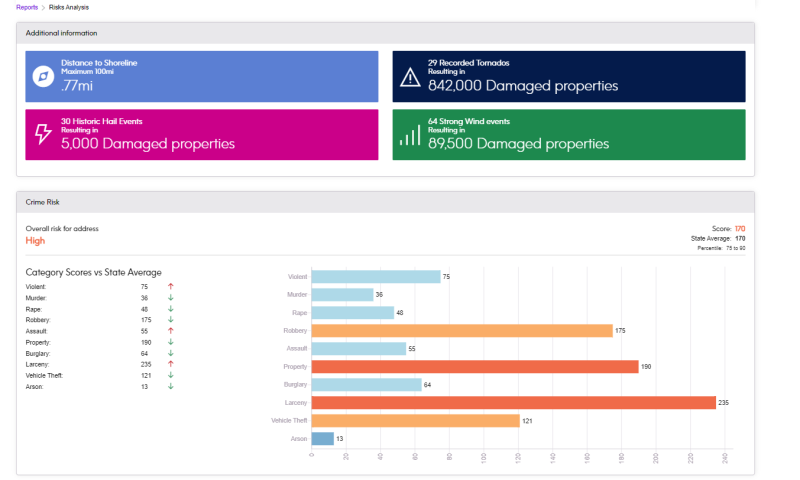Key Takeaways
- Leverage location intelligence (LI) to make informed business decisions with spatial data insights.
- Use accessible LI tools to democratize data and enable competitive advantages.
- Ensure data accuracy and integrity of your location data to maximize the benefits of location intelligence.
It used to be that leveraging location data required specialized tools, advanced systems, and expert users. All business-critical insights would stay within specialized departments, preventing businesses from using location intelligence more effectively.
Luckily, that’s not the case anymore – it’s easier than ever to unlock the power of location intelligence for your business, whether you need deeper property insights, better risk assessment, stronger marketing campaigns, and more.
Let’s dive deeper and explore why location intelligence has become a top business priority, and what you need to consider when searching for a solution that meets your needs.
Why Location Intelligence Matters
In simple terms, location intelligence is your organization’s ability to understand and analyze spatial relationships in your data. This goes beyond simple mapping – it answers your most important questions so you can make sense of spatial relationships between the people, assets, and environmental factors that matter most to your business.
Imagine, for example, that you’re about to open a new brick-and-mortar location for your business. It’s a huge investment, and you can’t afford to make a mistake.
In your search for the ideal spot, metrics like real estate prices are important – but they’re not everything. You’d also want to know things like: do the demographics in the area align with your target audience? What does the competition look like nearby? What are customer commuting patterns, and is this location easily accessible for them?
This is where location intelligence (LI) shines – answering those key questions and unlocking insights that inform smarter data-driven decision-making.
30 Day Free Trial
Try MapInfo Pro Free for 30 Days
To explore the power of business-driven location intelligence, sign up for a free 30-day trial of MapInfo Pro: a complete desktop mapping solution that enables you to visualize, analyze, edit, interpret, and output data — revealing relationships, patterns, and trends.
Trending Now: Location Intelligence Drivers
Spatial analytics tools aren’t new to the marketplace – in fact, some have been around for decades. But more recently, there’s been a rapidly increasing demand for these capabilities. But why now, after all these years? There are some major driving factors:
- Explosion of data. The sheer amount of data available today has grown exponentially. A growing number of technical and business users need access to location data to drive downstream analytics and daily operations.
This increase in data volume and users has created a significant demand for location intelligence.
- Democratization of tools. Location intelligence tools are more accessible and easier to use than ever before. What was once the domain of specialized departments is now available to a broader range of users – including customers who use LI in their daily lives for everything from traffic updates to finding great nearby restaurants.
Companies want to spend less time on data preparation and more time deriving insights from easy-to-access location reports.
- Enabling competitive advantage. In tough business climates, location intelligence proves to be a key market differentiator. It helps you reduce risks, maintain customer satisfaction, and maximize internal resources.
Which Type of Location Intelligence Solution is Right for You?
Every organization’s use cases for location intelligence are different, but here are three common types of solutions you can leverage:
1. Ad hoc mapping: A flexible tool that allows you to bring data from various sources and rapidly expose patterns and trends. For example, using MapInfo Pro, you can compare demographics and walkability ratings between two potential store locations and make on-the-fly decisions based on location data.
Key benefits:
- flexibility
- rapid exposure of patterns and trends
- immediate decision-making capabilities

2. Location-based reports: These reports are accessible and operationally efficient, providing comprehensive information with minimal effort.
For instance, by simply typing in an address (with the help of autocomplete capabilities to ensure accuracy), an insurance underwriter can create a risk analysis report with details like natural risks, crime risks, and existing policies in the area.
Key benefits:
- accessibility
- operational efficiency
- error-proof

3. Location data management and analytics: This solution is ideal if your organization needs to orchestrate large volumes of spatial data. It supports data science and spatial modeling tasks, providing scalability and comprehensive insights.
For example, a fast-food chain needing to consolidate could use a location data management and analytics platform to track performance across thousands of locations to make an informed decision.
Key benefits:
- orchestration of location-based data
- data science and spatial modeling
- scalability

Key Considerations
In your search for an effective location intelligence solution, remember to keep these overall considerations in mind to ensure it meets all the capabilities you need:
- Strong addresses and high-quality location data facilitate location intelligence. Spatial analytics help you discover relationships that empower key business initiatives, and it all starts with accurate, consistent, and complete location data. Without data integrity, you won’t get the meaningful insights you need for confident and powerful decision-making.
- Location intelligence goes beyond mapping. The value of location intelligence extends beyond simple mapping. It provides both operational and analytical value, so you can accelerate your time to market and reduce operational costs.
- Build data integrity with accuracy and context. Ensuring data accuracy and context is essential. This involves validating customer data, removing errors, and enriching datasets with additional attributes. For instance, geocoding ensures location accuracy, and then assigning a PreciselyID facilitates fast, easy data enrichment and linking.
It’s time to make location data work for you. Whichever solution you choose needs to be able to power decision-making that helps you achieve and exceed your top objectives.
Make the Most of Your Location Data
Location intelligence brings the most relevant, accurate, and actionable information to those who need it for better business decisions. If you haven’t embarked on the location journey yet, let’s get you started.
To explore the power of business-driven location intelligence, sign up for a free 30-day trial of MapInfo Pro: a complete desktop mapping solution that enables you to visualize, analyze, edit, interpret, and output data — revealing relationships, patterns, and trends.
Open up new opportunities through meaningful and timely access to location-based context today.







